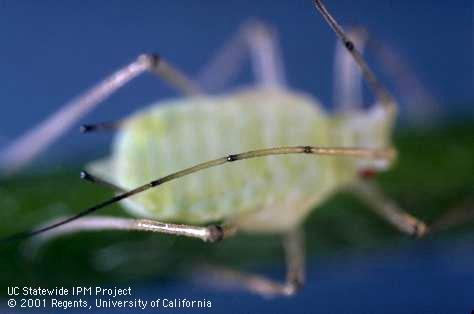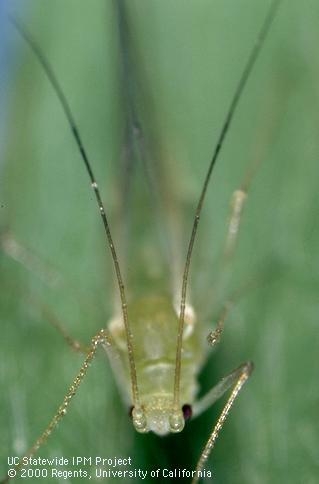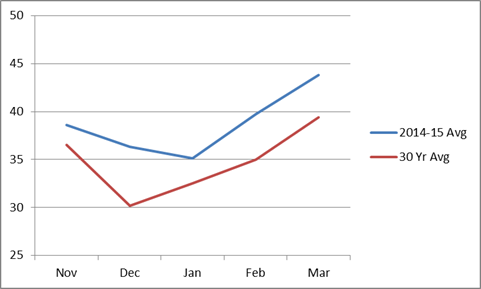Tuesday afternoon (3/31) Nick Macy from Macy's Flying Service and IREC Director Rob Wilson looked at some alfalfa fields in the Tulelake area that exhibited poor growth this spring. The severe stunting looked similar to stem nematode—a common occurrence seen in the spring in the intermountain area when alfalfa is just breaking dormancy. Stem nematode damage has been observed in several fields in the intermountain area this spring, but this damage was not stem nematode. Upon closer inspection, the young alfalfa shoots were absolutely covered with aphids. Samples were collected and we examined them under a microscope at IREC and they definitely appeared to be the blue alfalfa aphid rather than pea aphid (Figure 1A & B). Distinguishing between blue alfalfa aphid and pea aphid is important because blue alfalfa aphid actually injects a toxin into the alfalfa stunting plant growth, whereas, pea aphid does not. Therefore, the economic threshold (the aphid population level at which treatment is advised) for blue alfalfa aphid is lower.
The easiest way to differentiate blue alfalfa aphid and pea aphid is to examine the antennae. The antennae of the pea aphid has narrow dark bands at the end of each segment (Fig. 1A), whereas the blue alfalfa aphid has uniformly brown antennae without dark bands (Fig. 1B).
Blue alfalfa aphid has been a HUGE problem in the Central Valley and Low Desert areas of California the previous two years but not this year. This year was wetter so it is believed that a beneficial fungus that is favored by moist conditions that attacks aphids kept the population more in check or beneficial insects were more effective this year for some reason.
Why we have such high aphid populations so early on such young alfalfa is not known. Aphids do overwinter in alfalfa fields in the warmer areas of California but our winters are typically too cold. Perhaps this winter was so mild that the aphids were able to survive in the fields and overwinter and that is why they are back with a vengeance at such high numbers this year. The graph below shows average temperature for the months of November 2014 through March of this year compared with the 30-year average temperatures for the same months (Figure 2).
Every month was significantly warmer than the 30-year average (over the 5 month time period temperatures were 4 degrees warmer). Most people don't recall ever experiencing a winter this warm in this area before. Whether this was mild enough to allow the aphids to overwinter in the alfalfa fields or not is not known, but I'm confident it contributed to the high aphid populations we are observing in alfalfa fields now.
We have had some aphid outbreaks in Tulelake and areas of Lassen County last year but nothing anywhere near this early and probably not this infestation level either. Populations vary considerably among fields. So what should a grower do? I'd recommend scouting fields often to monitor the population. There is no economic threshold for fields this short. The decision whether to treat will have to be somewhat subjective. With the population level observed in many fields we saw yesterday, treatment is clearly needed. You could easily see the damage in many fields without even getting out of the pickup (though getting out on your hands and knees to inspect the plants is imperative). In the heavily infested fields, the knees area on your pants will turn green from all the squished aphids. There are a fair number of beneficial insects in some fields already (lady bird beetle adults and larvae primarily) but they will likely not be able to keep up with this aphid population, which is obviously already holding back alfalfa growth. Remember, this blue alfalfa aphid injects a toxin in the plant that stunts alfalfa growth. So fields with high populations will require treatment soon or the aphids will continue to hold back the growth. Symptoms may be worse in fields recently treated with an herbicide because aphid damage is oftentimes exacerbated on stressed plants.
A difficult question is which insecticide to use. Blue alfalfa aphids have been extremely difficult to control in recent years in other areas and the wrong approach has resulted in fields needing to be treated several times. There are two approaches most likely to be effective.
1) Use an insecticide that is safer and less disruptive to the population of beneficial insects so that although it may not control all the aphids, many beneficial insects survive and their population builds keeping the aphids below damaging levels.
2) Use a combination of insecticides that together are highly effective on aphids providing an excellent initial kill. Although the insecticide combination is lethal to most of the beneficials, the control is hopefully great enough that if the population does eventually resurge, enough time will have lapsed for the beneficials to have recovered.
In other areas, serious problems have arisen when a partially effective insecticide has been used alone that knocks back the aphids but kills most of the beneficials. In this situation, the aphid population has resurged largely unchecked by beneficials and significant alfalfa yield reductions have resulted and/or multiple insecticide treatments were needed.
The best insecticide for Approach 1 above would be to use the newly registered insecticide Beleaf. It has not been widely used on alfalfa yet because its registration is so new and because of a 62 day pre-harvest interval (PHI). Because of its mechanism of action it is safer to beneficials. The drawback is that it is more costly than many alternatives and it does not control weevils if they are present in the field at the same time. The 62 day PHI has been an issue in other areas but there will likely be sufficient time in our area if fields are treated real soon.
A treatment combination that has been effective for Approach 2 above is a tank mix of a high rate of dimethoate with Baythroid or Warrior (or their generic versions). The main drawback of this approach is the possibility of the aphids resurging after treatment and requiring an additional treatment.
There are still a lot of unknowns about these new blue alfalfa aphid infestations in the intermountain area and in other parts of California. Why has this aphid become so difficult to control and why have population levels been so much higher than normal? Since we are finding aphids so early this year does that mean it will be a problem throughout much of the season this year? We don't have a lot of answers yet, but this promises to be an interesting year with the moderate temperatures we have had this winter and we will learn more about the behavior of this aphid under our climatic conditions.
Fortunately, there is interest in new insecticide registrations in alfalfa that look very promising for aphid control. The one that is closest to registration in California is Sivanto by Bayer. This product just completed the 30-day public comment period and is likely to be registered by the middle of this month. Initial results with this product look promising.
While we clearly don't know all the answers about this blue alfalfa aphid infestation, the intent of this blog is to inform you of the problem so it doesn't catch you by surprise and you can take appropriate action (monitor population levels in your field and treat if necessary) to avoid the potential level of damage blue alfalfa aphid can cause.


